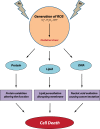Toxicity of lead: A review with recent updates
- PMID: 23118587
- PMCID: PMC3485653
- DOI: 10.2478/v10102-012-0009-2
Toxicity of lead: A review with recent updates
Abstract
Lead poisoning has been recognized as a major public health risk, particularly in developing countries. Though various occupational and public health measures have been undertaken in order to control lead exposure, cases of lead poisoning are still reported. Exposure to lead produces various deleterious effects on the hematopoietic, renal, reproductive and central nervous system, mainly through increased oxidative stress. These alterations play a prominent role in disease manifestations. Modulation of cellular thiols for protection against reactive oxygen species (ROS) has been used as a therapeutic strategy against lead poisoning. N-acetylcysteine, α-lipoic acid, vitamin E, quercetin and a few herbal extracts show prophylaxis against the majority of lead mediated injury in both in vitro and in vivo studies. This review provides a comprehensive account of recent updates describing health effects of lead exposure, relevant biomarkers and mechanisms involved in lead toxicity. It also updates the readers about recent advances in chelation therapy and newer therapeutic strategies, like nanoencapsulation, to treat lead induced toxic manifestations.
Keywords: antioxidants; lead toxicity; reactive oxygen species.
Figures








References
-
- Agarwal R, Goel SK, Behari JR. Detoxification and antioxidant effects of curcumin in rats experimentally exposed to mercury. J Appl Toxicol. 2010;30:457–468. - PubMed
-
- Agency for Toxic Substances and Disease Registry (ATSDR) Atlanta, GA: U.S. Department of Health and Human Services, Public Health Service; 2005. Toxicological profile for lead. (Draft for Public Comment) pp. 43–59.
-
- Ahamed M, Siddiqui MKJ. Environmental lead toxicity and nutritional factors. Clin Nut. 2007;26:400–408. - PubMed
-
- Ahamed M, Siddiqui MKJ. Low level lead exposure and oxidative stress: Current opinions. Clin Chim Acta. 2007;383:57–64. - PubMed
-
- Ahamed M, Verma S, Kumar A, Siddiqui MK. Environmental exposure to lead and its correlation with biochemical indices in children. Sci Total Environ. 2005;346:48–55. - PubMed
LinkOut - more resources
Full Text Sources
